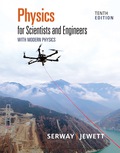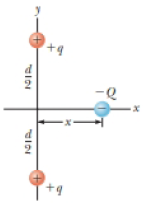
EBK PHYSICS FOR SCIENTISTS AND ENGINEER
10th Edition
ISBN: 8220106740163
Author: SERWAY
Publisher: CENGAGE L
expand_more
expand_more
format_list_bulleted
Concept explainers
Textbook Question
Chapter 22, Problem 13P
Review. Two identical particles, each having charge +q, are fixed in space and separated by a distance d. A third particle with charge −Q is free to move and lies initially at rest on the perpendicular bisector of the two fixed charges a distance x from the midpoint between those charges (Fig. P22.13). (a) Show that if x is small compared with d, the motion of −Q is simple harmonic along the perpendicular bisector. (b) Determine the period of that motion. (c) How fast will the charge −Q be moving when it is at the midpoint between the two fixed charges if initially it is released at a distance a << d from the midpoint?
Figure P22.13

Expert Solution & Answer
Trending nowThis is a popular solution!

Students have asked these similar questions
Consider a rubber rod that has been rubbed with fur to give the rod a net negative charge, and a glass rod that has been rubbed with silk to give it a net positive charge. After being charged by contact by the fur and silk...?
a. Both rods have less mass
b. the rubber rod has more mass and the glass rod has less mass
c. both rods have more mass
d. the masses of both rods are unchanged
e. the rubber rod has less mass and the glass rod has mroe mass
8) 9)
10)
11)
12)
13)
14)
15)
Chapter 22 Solutions
EBK PHYSICS FOR SCIENTISTS AND ENGINEER
Ch. 22.1 - Three objects are brought close to each other, two...Ch. 22.2 - Three objects are brought close to one another,...Ch. 22.3 - Object A has a charge of +2 C, and object B has a...Ch. 22.4 - A test charge of +3 C is at a point P where an...Ch. 22.5 - Rank the magnitudes of the electric field at...Ch. 22 - Find to three significant digits the charge and...Ch. 22 - (a) Find the magnitude of the electric force...Ch. 22 - In a thundercloud, there may be electric charges...Ch. 22 - Nobel laureate Richard Feynman (19181088) once...Ch. 22 - A 7.50-nC point charge is located 1.80 m from a...
Ch. 22 - This afternoon, you have a physics symposium...Ch. 22 - Two small beads having positive charges q1 = 3q...Ch. 22 - Two small beads having charges q1 and q2 of the...Ch. 22 - Review. In the Bohr theory of the hydrogen atom,...Ch. 22 - Three point charges lie along a straight line as...Ch. 22 - A point charge +2Q is at the origin and a point...Ch. 22 - Particle A of charge 3.00 104 C is at the origin,...Ch. 22 - Review. Two identical particles, each having...Ch. 22 - Why is the following situation impossible? Two...Ch. 22 - What are the magnitude and direction of the...Ch. 22 - Consider n equal positively charged particles each...Ch. 22 - Two equal positively charged particles are at...Ch. 22 - Two charged particles are located on the x axis....Ch. 22 - Three point charges are located on a circular arc...Ch. 22 - Two 2.00-C point charges are located on the x...Ch. 22 - Three point charges are arranged as shown in...Ch. 22 - Consider the electric dipole shown in Figure...Ch. 22 - Three equal positive charges q are at the corners...Ch. 22 - A proton accelerates from rest in a uniform...Ch. 22 - A proton moves at 4.50 105 m/s in the horizontal...Ch. 22 - Protons are projected with an initial speed vi =...Ch. 22 - You are still fascinated by the process of inkjet...Ch. 22 - You are working on a research project in which you...Ch. 22 - Consider an infinite number of identical...Ch. 22 - A particle with charge 3.00 nC is at the origin,...Ch. 22 - A small block of mass m and charge Q is placed on...Ch. 22 - A small sphere of charge q1 = 0.800 C hangs from...Ch. 22 - A charged cork ball of mass 1.00 g is suspended on...Ch. 22 - A charged cork ball of mass m is suspended on a...Ch. 22 - Three charged particles are aligned along the x...Ch. 22 - Two point charges qA = 12.0 C and qB = 45.0 C and...Ch. 22 - Two small spheres hang in equilibrium at the...Ch. 22 - Four identical charged particles (q = +10.0 C) are...Ch. 22 - Review. Two identical blocks resting on a...Ch. 22 - Review. Two identical blocks resting on a...Ch. 22 - Three identical point charges, each of mass m =...Ch. 22 - Why is the following situation impossible? An...Ch. 22 - Two hard rubber spheres, each of mass m = 15.0 g,...Ch. 22 - Two identical beads each have a mass m and charge...Ch. 22 - Two small spheres of mass m are suspended from...Ch. 22 - You are working as an expert witness for an...Ch. 22 - Review. A 1.00-g cork ball with charge 2.00 C is...Ch. 22 - Eight charged panicles, each of magnitude q, are...Ch. 22 - Two particles, each with charge 52.0 nC, are...Ch. 22 - Review. An electric dipole in a uniform horizontal...
Knowledge Booster
Learn more about
Need a deep-dive on the concept behind this application? Look no further. Learn more about this topic, physics and related others by exploring similar questions and additional content below.Similar questions
- Mick and Rick are twins born on Earth in the year 2175. Rick grows up to be an Earth-bound robotics technician while Mick becomes an intergalactic astronaut. Mick leaves the Earth on his first space mission in the year 2200 and travels, according to his clock, for 10 years at a speed of 0.75c. Unfortunately, at this point in his journey, the structure of his ship undergoes mechanical breakdown and the ship explodes. How old is Rick when his brother dies?arrow_forwardHi, I have canceled, why did you charge me again?arrow_forwardNo chatgpt pls will upvotearrow_forward
arrow_back_ios
SEE MORE QUESTIONS
arrow_forward_ios
Recommended textbooks for you
 Principles of Physics: A Calculus-Based TextPhysicsISBN:9781133104261Author:Raymond A. Serway, John W. JewettPublisher:Cengage Learning
Principles of Physics: A Calculus-Based TextPhysicsISBN:9781133104261Author:Raymond A. Serway, John W. JewettPublisher:Cengage Learning Physics for Scientists and Engineers: Foundations...PhysicsISBN:9781133939146Author:Katz, Debora M.Publisher:Cengage Learning
Physics for Scientists and Engineers: Foundations...PhysicsISBN:9781133939146Author:Katz, Debora M.Publisher:Cengage Learning Physics for Scientists and Engineers with Modern ...PhysicsISBN:9781337553292Author:Raymond A. Serway, John W. JewettPublisher:Cengage Learning
Physics for Scientists and Engineers with Modern ...PhysicsISBN:9781337553292Author:Raymond A. Serway, John W. JewettPublisher:Cengage Learning Physics for Scientists and EngineersPhysicsISBN:9781337553278Author:Raymond A. Serway, John W. JewettPublisher:Cengage Learning
Physics for Scientists and EngineersPhysicsISBN:9781337553278Author:Raymond A. Serway, John W. JewettPublisher:Cengage Learning College PhysicsPhysicsISBN:9781938168000Author:Paul Peter Urone, Roger HinrichsPublisher:OpenStax College
College PhysicsPhysicsISBN:9781938168000Author:Paul Peter Urone, Roger HinrichsPublisher:OpenStax College Physics for Scientists and Engineers, Technology ...PhysicsISBN:9781305116399Author:Raymond A. Serway, John W. JewettPublisher:Cengage Learning
Physics for Scientists and Engineers, Technology ...PhysicsISBN:9781305116399Author:Raymond A. Serway, John W. JewettPublisher:Cengage Learning

Principles of Physics: A Calculus-Based Text
Physics
ISBN:9781133104261
Author:Raymond A. Serway, John W. Jewett
Publisher:Cengage Learning

Physics for Scientists and Engineers: Foundations...
Physics
ISBN:9781133939146
Author:Katz, Debora M.
Publisher:Cengage Learning

Physics for Scientists and Engineers with Modern ...
Physics
ISBN:9781337553292
Author:Raymond A. Serway, John W. Jewett
Publisher:Cengage Learning

Physics for Scientists and Engineers
Physics
ISBN:9781337553278
Author:Raymond A. Serway, John W. Jewett
Publisher:Cengage Learning

College Physics
Physics
ISBN:9781938168000
Author:Paul Peter Urone, Roger Hinrichs
Publisher:OpenStax College

Physics for Scientists and Engineers, Technology ...
Physics
ISBN:9781305116399
Author:Raymond A. Serway, John W. Jewett
Publisher:Cengage Learning
Electric Fields: Crash Course Physics #26; Author: CrashCourse;https://www.youtube.com/watch?v=mdulzEfQXDE;License: Standard YouTube License, CC-BY